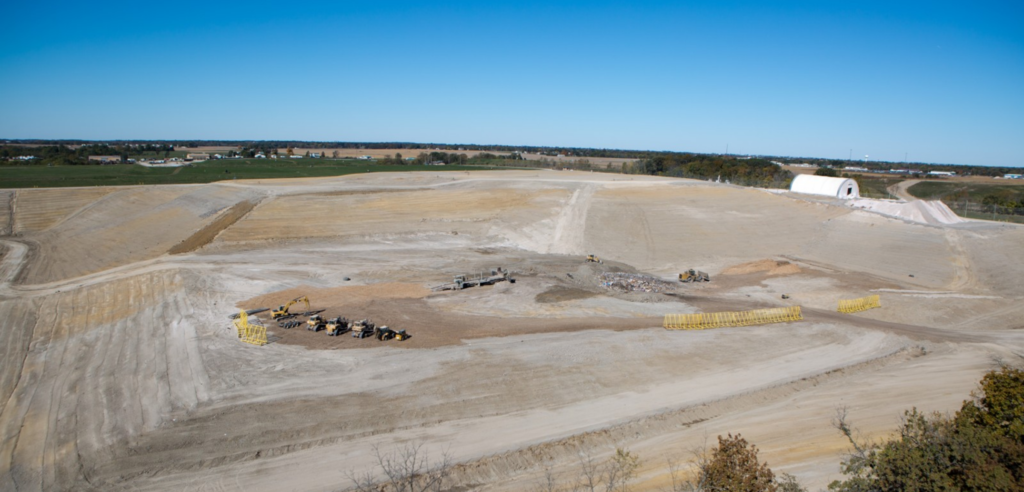Clinton Landfill Gas Project

Landfills are often associated with waste and pollution, but innovative technologies are transforming them into sources of renewable energy. The Clinton Landfill Gas project in DeWitt County, Illinois, is a prime example of how landfill gas-to-energy (LFGTE) systems can reduce greenhouse gas emissions, generate clean electricity, and support local communities. This article explores how the Clinton Landfill Gas project works, its environmental and economic benefits, and its role in combating climate change.
Table of Contents
What Is Landfill Gas?
Landfill gas is a byproduct of the decomposition of organic waste in landfills. It primarily consists of methane (CH₄) and carbon dioxide (CO₂), two potent greenhouse gases. Methane, in particular, is 25 times more effective at trapping heat in the atmosphere than CO₂ over a 100-year period.
In most landfills, this gas is burned off (flared) to prevent it from escaping into the atmosphere. However, landfill gas-to-energy systems like the one at Clinton capture this gas and convert it into electricity, turning a harmful byproduct into a valuable resource.
How the Clinton Landfill Gas Project Works
The Clinton Landfill Gas project employs advanced technology to capture methane emissions from decomposing waste. Here’s how it works:
- Gas Collection: The landfill is equipped with a series of 50 wells that extract methane and other gases.
- Gas Processing: The collected gas is piped to a processing facility where impurities are removed.
- Energy Conversion: The purified methane is burned in two 1.6 MW Caterpillar generator sets to produce electricity (source).
- Emission Reduction: Burning the methane destroys hazardous air pollutants and volatile organic compounds (VOCs), improving local air quality.
This system captures between 60% and 90% of the methane emitted by the landfill, depending on its effectiveness (source).
Environmental Benefits
1. Reducing Greenhouse Gas Emissions
By capturing and converting methane into electricity, the Clinton project prevents this potent greenhouse gas from escaping into the atmosphere. This action significantly reduces the landfill’s overall carbon footprint.
2. Improving Air Quality
The combustion process destroys VOCs and other hazardous pollutants that can cause respiratory irritation or more severe health issues (source). This results in cleaner air for nearby communities.
3. Displacing Fossil Fuels
The electricity generated by the Clinton facility displaces energy that would otherwise come from fossil fuel power plants. This contributes to a more sustainable energy mix in Illinois.
Economic Benefits
1. Renewable Energy Production
The Clinton project generates 3.2 MW of electricity—enough to power approximately 3,500 homes annually (source).
2. Job Creation
The construction and ongoing maintenance of the landfill gas system support local jobs, boosting economic activity in DeWitt County.
3. Revenue Sharing
Revenues from electricity sales are shared between project operators and local stakeholders, ensuring that economic benefits stay within the community (source).

Co-Benefits for Local Communities
Beyond reducing emissions and generating renewable energy, the Clinton Landfill Gas project provides additional benefits:
- Health Improvements: By destroying harmful air pollutants, the project reduces health risks for nearby residents.
- Odor Control: Capturing landfill gas minimizes unpleasant odors associated with waste decomposition (source).
- Land Use Optimization: The project transforms what was once considered waste into a valuable resource, demonstrating innovative land use practices.
The Role of Transparency in Landfill Gas Projects
Transparency is essential for ensuring that landfill gas projects deliver on their promises of environmental and economic benefits. The Clinton Landfill Gas project exemplifies best practices by providing detailed information about its operations, emission reductions, and energy production.
Verified carbon credits associated with projects like Clinton are tracked through registries such as Verra or Gold Standard. These certifications ensure that emission reductions are real, measurable, and permanent.
By partnering with trusted platforms like CNaught, Coffset ensures that every contribution supports verified projects like Clinton, giving users confidence in their impact.
Why Landfill Gas-to-Energy Matters for Climate Action
Municipal solid waste landfills are the third-largest source of human-related methane emissions in the United States (source). Projects like Clinton play a critical role in addressing this issue by:
- Capturing methane before it escapes into the atmosphere.
- Converting waste into renewable energy to reduce reliance on fossil fuels.
- Demonstrating scalable solutions for waste management and emission reduction.
As part of a broader strategy to combat climate change, landfill gas-to-energy projects complement other renewable energy sources like wind and solar while addressing methane emissions—a key driver of global warming.
Conclusion: A Model for Sustainable Waste Management
The Clinton Landfill Gas project showcases how innovative technology can transform waste management into an opportunity for climate action. By capturing harmful greenhouse gases and converting them into clean energy, this project reduces emissions, improves air quality, and supports local communities.
Coffset proudly supports verified projects like Clinton through partnerships with CNaught to ensure transparency and measurable impact. Take action today—calculate your carbon impact using Coffset’s carbon footprint calculator and contribute to projects that make a real difference!
References:
https://3degreesinc.com/projects/clinton-landfill-gas-collection-and-combustion-project-carbon-credits/
https://icap.sustainability.illinois.edu/files/project/3114/Landfill_Emissions_Raw_Data.xlsx
https://archive.epa.gov/region5/waste/clintonlandfill/web/pdf/cl_222.pdf
https://epa.illinois.gov/content/dam/soi/en/web/epa/documents/community-relations/clinton-landfill-3/clinton-20lf-208-26-15.pdf
https://native.eco/project/clinton-county-landfill/
https://carbonplan.org/research/icvcm-landfill-additionality
https://www.ccaswa.com/docs/minutes/20230720.pdf
https://www.mvr.usace.army.mil/Portals/48/docs/regulatory/publicnotices/2021/PUBLIC%20NOTICE%202019-0367%20Clinton%20Landfill%20Inc.pdf?ver=3XUmvteBzQkVZ8ct5VsOXw%3D%3D